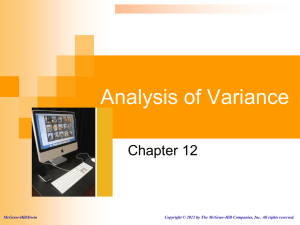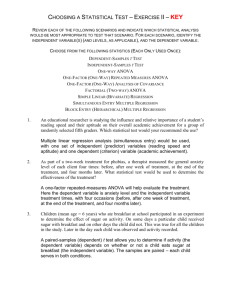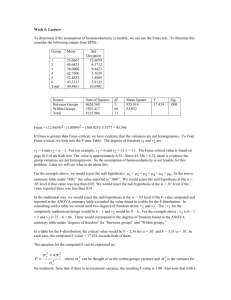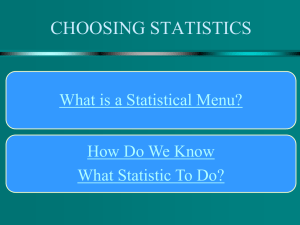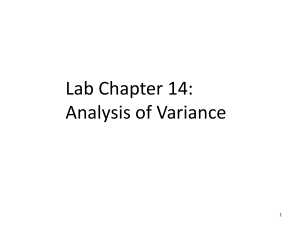Anova
advertisement
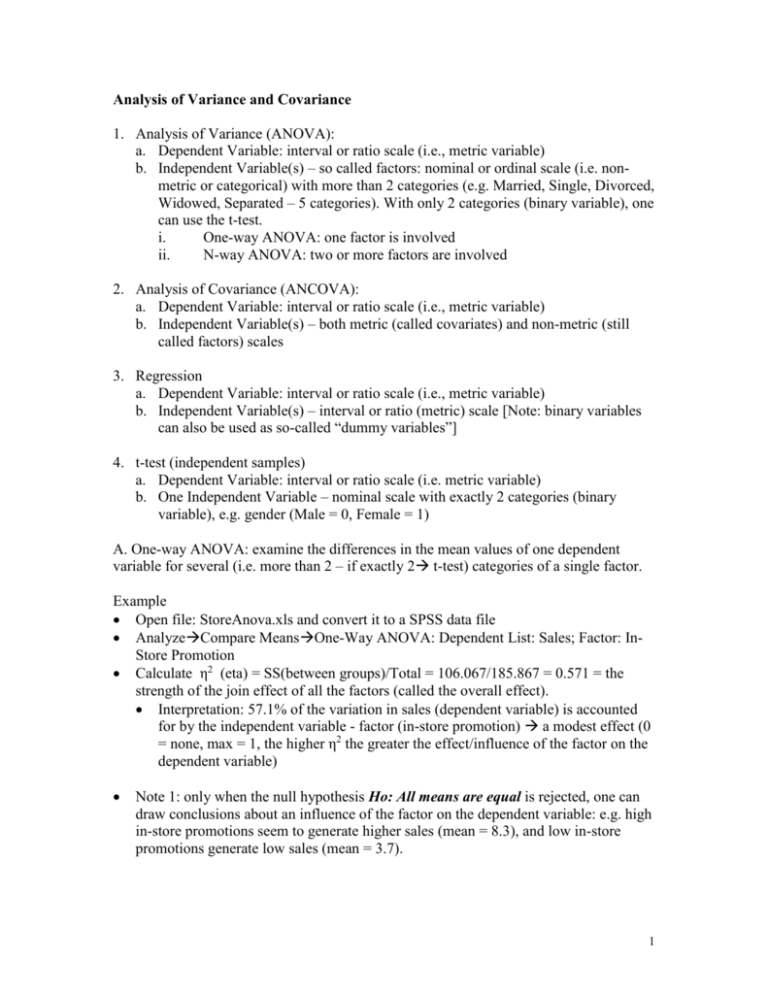
Analysis of Variance and Covariance 1. Analysis of Variance (ANOVA): a. Dependent Variable: interval or ratio scale (i.e., metric variable) b. Independent Variable(s) – so called factors: nominal or ordinal scale (i.e. nonmetric or categorical) with more than 2 categories (e.g. Married, Single, Divorced, Widowed, Separated – 5 categories). With only 2 categories (binary variable), one can use the t-test. i. One-way ANOVA: one factor is involved ii. N-way ANOVA: two or more factors are involved 2. Analysis of Covariance (ANCOVA): a. Dependent Variable: interval or ratio scale (i.e., metric variable) b. Independent Variable(s) – both metric (called covariates) and non-metric (still called factors) scales 3. Regression a. Dependent Variable: interval or ratio scale (i.e., metric variable) b. Independent Variable(s) – interval or ratio (metric) scale [Note: binary variables can also be used as so-called “dummy variables”] 4. t-test (independent samples) a. Dependent Variable: interval or ratio scale (i.e. metric variable) b. One Independent Variable – nominal scale with exactly 2 categories (binary variable), e.g. gender (Male = 0, Female = 1) A. One-way ANOVA: examine the differences in the mean values of one dependent variable for several (i.e. more than 2 – if exactly 2 t-test) categories of a single factor. Example Open file: StoreAnova.xls and convert it to a SPSS data file AnalyzeCompare MeansOne-Way ANOVA: Dependent List: Sales; Factor: InStore Promotion Calculate η2 (eta) = SS(between groups)/Total = 106.067/185.867 = 0.571 = the strength of the join effect of all the factors (called the overall effect). Interpretation: 57.1% of the variation in sales (dependent variable) is accounted for by the independent variable - factor (in-store promotion) a modest effect (0 = none, max = 1, the higher η2 the greater the effect/influence of the factor on the dependent variable) Note 1: only when the null hypothesis Ho: All means are equal is rejected, one can draw conclusions about an influence of the factor on the dependent variable: e.g. high in-store promotions seem to generate higher sales (mean = 8.3), and low in-store promotions generate low sales (mean = 3.7). 1 Note 2: fixed-effects model (when the categories of the factor are fixed as in our example). If not (i.e., are random) random-effects model. Example of random-effects model: suppose you collect data on the amount of insect damage (dependent variable- metric) done to different varieties of wheat (factors). It is impractical to study insect damage for every possible variety of wheat, so, to conduct an experiment, you randomly select 4 varieties of wheat to study. Finally, a mixed-effects model is a mixture of the two above. B. N-way ANOVA Analyze General Linear ModelUnivariate: Dependent Variable: Sales; Fixed Factor(s): Coupon and In-Store Promotion Options (check Descriptive statistics) Very important: Step 1: Test whether the overall effect is significant. In our example, F for the (Corrected) Model is 33.655 and Sig. = 0.000 which indicates that the overall effect is significant at the 0.05 level. Only then, you may go to the second step. Step 2: Test whether the interaction effect between the factors is significant. In our example, F for the interaction effect is 1.690 and Sig. = 0.206> >0.05The interaction effect is NOT significant at the 0.05 level. Only then, you can continue and analyze the main effects individually, one by one, in Step 3 Step 3: Test the significance of the main effect for each individual factor The Promotion effect has Sig. 0.000 < 0.05 Statistically significant at the 0.05 level The Coupon effect has Sig. 0.000 < 0.05 Statistically significant at the 0.05 level as well. Interpretation: The higher level of promotion results in higher sales. The wider distribution of coupons results in higher sales as well. However, the two factors are independent on each other (they do not act in tandem, no interaction). C. Try also the one-way ANOVA with Coupon as the factor. AnalyzeCompare MeansOne-Way ANOVA: Dependent List: Sales; Factor: Coupon D. Analysis of Covariance – ANCOVA (most useful when the covariate is linearly related to the dependent variable and is not related to the factors). Analyze General Linear ModelUnivariate: Dependent Variable: Sales; Fixed Factor(s): Coupon and In-Store Promotion Covariate(s): Clientele (because it is measured on the interval scale)Options (check the first 4 boxes under Display) 2 Y = 2.574 + 3.4*Coupon1 + 5.4*Promotion1 + 2.8*Promotion2 – 1.6*Coupon1*Promotion1 (Note: the last term is significant only at 10%, not 5%) e.g. Ycoupon1, promotion1 = 2.0 + 3.4 + 5.4 - 1.6 = 9.2 Note that Clientele turned out not to be significant (Sig. = 0.363) Issues in Interpretation of ANOVA (go back to the n-way ANOVA solution) (1) Relative Importance of Factors Measure: (omega) ω2 = SSx – (dfx * Mserror)/(SStotal + Mserror) E.g. for in-store promotion: ω2 = Numerator/Denominator Numerator = 106.067 – (2 * 0.967) = 104.133 Denominator = 185.867 + 0.967 = 186.834 ω2 = Numerator/Denominator = 104.133/186.834 = 0.557 for in-store promotion ω2 = 0.280 for couponing Rule of thumb: large experimental effect: when ω2 >= 0,15 Medium experimental effect: when ω2 = app. 0.06 Small experimental effect: when ω2 = app. 0.01 (2) Multiple Comparisons Click “PostHoc”paste two factors into Post Hoc Tests forcheck LSD (Least Significance Difference) Outcome: all pairs of means are significantly different E. Multivariate Analysis of Variance (MANOVA) MANOVA should be used only when the (more than 2) dependent variables are correlated. If they are NOT correlated, use ANOVA on each dependent variable separately. How to check whether the dependent variables Sales and Clientel are correlated? AnalyzeCorrelateBivariatePaste the Variables (Sales, Clientele)OK Note: these variables are not correlated r = -0.067, Sig. = 0.724 If the dependent variables are correlated (let’s assume that our two variables are correlated), then: AnalyzeGeneral Linear ModelMultivariateDependent Variables (Sales, Clientele), Fixed Factors (Coupon, In-Store Promotion) OK 3 4



